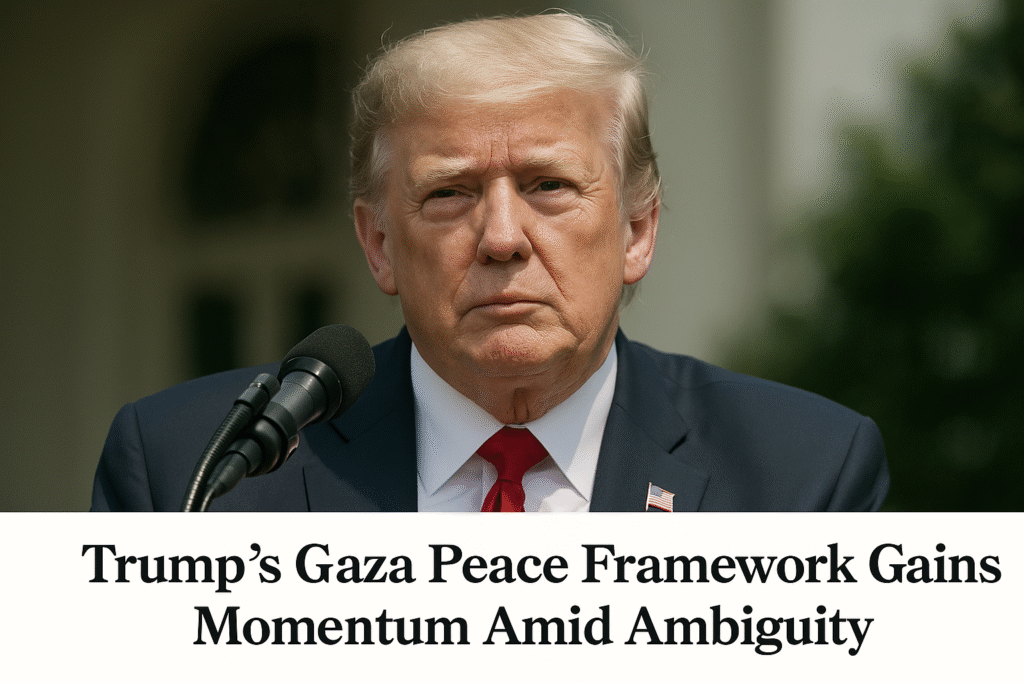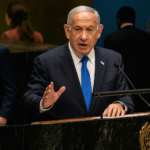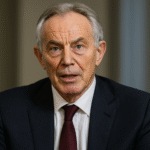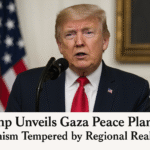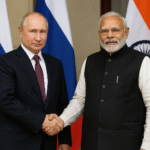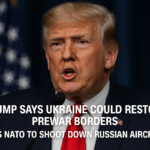By Harshit, October 1, 2025 | Washington D.C. | 5:30 AM EDT
Donald Trump’s framework agreement for ending the Gaza war and reconstructing the territory has generated significant momentum, driven both by the US president himself and by key Arab and Islamic countries. Nations including Jordan, Egypt, Qatar, Saudi Arabia, the UAE, Pakistan, Indonesia, and Turkey have publicly endorsed the plan, giving it international backing. Even Israel’s Prime Minister Benjamin Netanyahu accepted the framework, despite its vague references to a potential pathway toward a Palestinian state—something he has repeatedly opposed.
To maintain momentum, Trump has given Hamas only “three to four days” to respond to the proposal. Should Hamas reject it, the war would continue.
Similarities with Previous Plans
Observers note that the framework resembles an earlier peace initiative put forward by President Joe Biden over a year ago. Since then, Gaza has endured massive civilian casualties, extensive infrastructure destruction, and a worsening famine, while Israeli hostages in the territory have faced prolonged captivity. Reports in the Israeli media suggested that Biden’s plan faltered largely because Netanyahu adjusted demands under pressure from hard-right cabinet members, demonstrating the political complexity of any Israeli-Palestinian negotiations.
Trump Puts Pressure on Israel
Despite past US failures, the Trump framework represents a notable moment in which the United States is actively pressuring Israel to end hostilities. For the first time, Trump has positioned himself as a leader to whom Netanyahu finds it difficult to say no, drawing comparisons to other world leaders who faced intense scrutiny in the Oval Office.
Before departing Washington D.C., Netanyahu recorded a video message for Israeli citizens, emphasizing that while he supported Trump’s plan to end the war in Gaza, he would resist any notion of a Palestinian state. In the White House, however, he had endorsed the framework, stating it achieved Israel’s war aims and promised to bring back hostages, dismantle Hamas’ military capabilities, and neutralize Gaza as a threat.
Ambiguity in the Framework
The framework’s strength lies in its momentum and international support, but it also suffers from ambiguity. The document includes only a rough outline of IDF withdrawal stages and lacks the detailed mechanisms required to ensure a sustainable peace process. Experts warn that the absence of these nuts-and-bolts provisions creates multiple opportunities for the agreement to fail during negotiations.
Mainstream Israeli opposition parties have endorsed the plan, but far-right coalition members have condemned it. Many ultra-nationalists, including Netanyahu’s ally Itamar Ben Gvir, criticized the proposal as “dangerous” and “full of holes,” particularly because it rejects the earlier “Trump Riviera” plan, which envisioned relocating Gaza’s Palestinian population and building a new city for Israeli settlers. The new framework explicitly states that no Palestinian will be forcibly removed.
Negotiation Challenges Ahead
If Hamas agrees to the plan, Netanyahu may face pressure to balance the coalition’s extremist members while maintaining the broader peace framework. The structure of the agreement allows Israel multiple opportunities to veto or undermine proposals, raising concerns about whether a lasting ceasefire and reconstruction can be implemented.
Long-term observers emphasize that any peace process failing to acknowledge Palestinian self-determination is unlikely to achieve genuine stability. Arab and Islamic foreign ministers supporting the plan have highlighted that it could lead to a full Israeli withdrawal and rebuilding of Gaza, creating a pathway for a just two-state solution in accordance with international law—a reference, implicitly, to prior rulings of the International Court of Justice regarding occupation.
Two Interpretations, One Plan
The framework’s ambiguity allows both Israeli and Palestinian interpretations. Netanyahu sees it as moving Israel closer to victory over Hamas, denying Palestinians any claim to land between the Jordan River and the Mediterranean. Conversely, proponents of Palestinian independence view the plan as a potential step toward a two-state solution.
This duality underscores the fragility of the Trump initiative. While it has momentum and international endorsement, the lack of clarity, coupled with deeply entrenched political positions, suggests the path to peace remains uncertain. The coming days, particularly Hamas’ response, will determine whether the framework can shift from symbolic agreement to tangible resolution.

